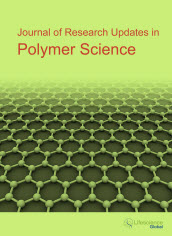jrups
|
|
Abstract: Two new series of polyamides and copolyamides based on methyl-cyclohexanone and tertiary-butyl-cyclohexanone in the main chain were synthesized via the solution polymerization of 2,6-bis(m-aminobenzylidene)-methylcyclohex-anone VI, 2,6-bis(m-aminobenzylidene)tertiary-butyl-cyclohexanone VIII, and its copolyamides with p-phenylene diamines and m-phenylene diamines with diacid chlorides of thianthrene (2,7-Dichloroformylthianthrene-5,5`,10,10`-tetraoxide IV. These polyamides and copolymides ranged from yellow to orange color and had inherent viscosity up to 0.35-0.89 dL/g. All the polyamides and copolymides were insoluble in common organic solvents but dissolved completely in concentrated H2SO4. The thermal stabilities of the prepared polyamides were evaluated by TGA and DTG analyses. X– ray analysis showed these polymers having low degree of crystallinity in the region 2q = 5 – 60°. The morphological properties of some selected polyamides were detected by SEM. Keywords: Polyamides, Copolyamides, Thianthrene, Thermal Properties, arylidene polymers.Download Full Article |
|
|
Abstract: Biodegradable Hydroxyl propyl Methyl cellulose based polymer composites of various concentrations were prepared by doping carbon particles of kerosene soot. These composites were synthesized by employing simple solution casting method, to study the physical properties of the same. The analytical studies like XRD, AC conductivity, Tensile strength, Acoustic impedance, AFM and FTIR spectroscopy were carried out to characterize these composites. From the results it is seen that, the amorphous carbon particle disturbs the semi crystalline nature of the polymer by getting interstitial into polymer network. Further, this results in the characteristic changes of other physical parameters like tensile strength and AC conductivity. We have made an attempt to establish a structure property relation of such changes in the physical properties with that of microstructural parameters derived from XRD. Keywords: HPMC, Carbon Soot, XRD, Crystallite Size.Download Full Article |
|
|
Abstract: Poly(vinyl chloride), PVC, stands as one of the best polymer candidates as far as polymeric materials are strongly sought for in our today’s life. Functionalization of poly(vinyl chloride) (PVC) remains an appropriate way to fashion materials for specific applications. Molecules of different functionalities and sizes, up to macromolecules, were affixed to PVC matrix. Graft polymerization led to functionalized PVC with several properties for different applications. Some covalently modified PVCs, mainly with heteroatom-containing and cyclic molecules, proved to be biologically active and efficient scaffolds for enzyme/protein immobilization. Suitable functionalizations of PVC even ensured the effectiveness of the polymers as separative, ion-selective electrode, and fuel cell membranes. Some modifying agents incorporated in PVC made the polymeric materials convenient and reliable for solar cells design. Reactions of PVC with metal chelating molecules engendered PVC-metal complexes that were efficient polymer-supported catalysts for Heck, Sonogashira, and Suzuki-Miyaura coupling reactions. Heavy metal sorbents were also made by tailored functionalization of PVC. Modifications of PVC with allotropic carbon nanoparticles, including fullerene C60, carbon nanotubes, and graphene and their applications in the nanocomposites making are herein discussed. The newly emerged “click chemistry” and “living controlled radical polymerization, LCRP” were exploited in the functionalization of poly(vinyl chloride). Keywords: Allotropic carbons, Applications, Functionalization, Membranes, Modification, Poly(vinyl chloride), PVC-supported catalysts.Download Full Article |
|
|
Abstract: In the present study, cotton fabric were prepared via coating with intumescent formulations of ammonium polyphosphate (APP), guanidine nitrate, penta erythritol (PER) and metal salts at different loading levels via ‘Pad-dry cure’ method. Thermal degradation behavior of prepared cotton derivatives was investigated by thermogravimetry (TG) and differential thermal analysis (DTA) from ambient temperature to 700 oC. Dynamic TG analysis was used to study the thermal degradation behavior of samples at four different heating rates of 2, 5, 10 and 20 oC min-1 in air atmosphere. The treated cotton fabric decomposes at lower temperatures and produces higher amount of char yields. The degradation activation energy was calculated using Friedman, modified Coats-Redfern and Ozawa-Flynn-Wall (O-F-W) iso-conversional model free methods. Tensile properties of coated fabric were found to be reduced with increase in loading of intumescent formulation but there was an abrupt increase in sample coated with intumescent and silica. With the insertion of iron (Fe) metal ion along with intumescent reduces the fabric strength due to formation of metal complexes with cotton cellulose which decreases the crosslinking. The maximum flame ratardancy of CF 12APP-Si among all cotton derivatives is suggested as the flame retardancy directly proportional to char yield (22 % at 650 oC) that is highest and inversely proportional to MMLR value (8.3 % min-1), that is least among all samples. Based on thermal and kinetic studies, the optimum concentration of flame retardant is worked out. Keywords: Model free kinetics,Thermal Analysis, CRA, Pad-Dry Cure, MMLR.Download Full Article |
|
|
Abstract: Kinetic regularities of thermooxidative dehydrochlorination of rigid and plasticized PVC in the presence of 5-hydroxy-6-methyluracil have been studied. The high antioxidant efficacy of 5-hydroxy-6-methyluracil in the process of polymer degradation has been revealed. It is shown that the studied uracil significantly slows down the process of accumulation of hydroperoxides in oxidation of dioctyl phthalate the plasticizer of PVC, which is the cause of a significant slowdown in the rate of decomposition of the plasticized polymer. Keywords: Polyvinyl chloride, thermooxidative dehydrochlorination, antioxidant, 5-hydroxy-6-methyluracil, low toxicity.Download Full Article |


